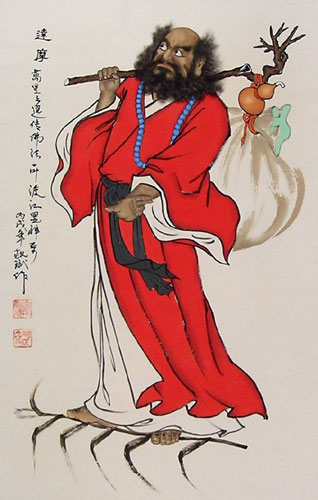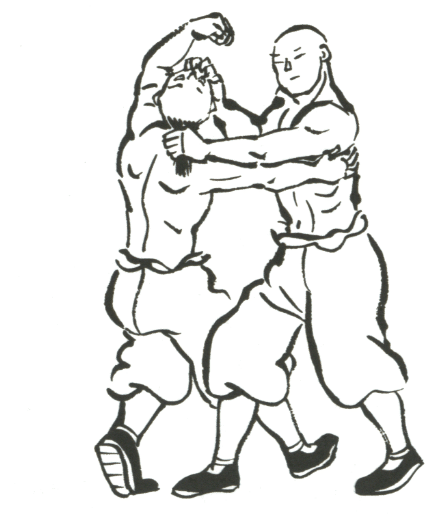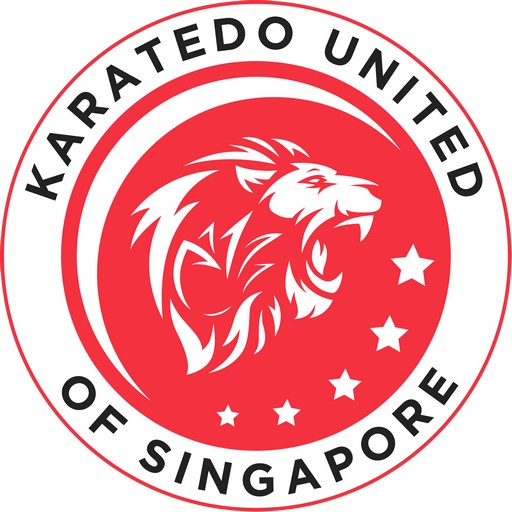Origin of Karate
Introduction to Karate
Karate is a system of self-defence and physical culture originally developed in Okinawa and later spread to Japan where it was refined.
The word karate is formed from the Japanese word “kara” (empty) and “Te”(hand), meaning that the practitioners are unarmed but use their hand and feet as defence and striking weapons.
i) The Beginning of Chinese Kempo
Bodhidharma (Da Mo) was a well-known Zen monk who spent nine years at Shaolin Temple in the Songshan mountains of China. Bodhidharma (Da Mo) was born in India about 1,400 years ago, the third child of King Sugandhain, and a member of the warrior caste. He is believed to have arrived at the foot of the Songshan Mountains in Hunan Province in China around 520 A.D. to lecture there on Buddhism. He spent his days in meditation facing the wall of a cave which was located in the vicinity of the temple.
There is no clear evidence to prove that the martial arts existed in China before the coming of Bodhidharma (Da Mo) in the 6th Century A.D., but it is likely that many different types of martial arts were already practiced and flourising in China long before the arrival of Bodhidharma (Da Mo). One theory purports that 5,000 years ago in China during the reign of Emperor Huang, the first fighting arts, similar to Kempo (chuan fa) appeared, and, by the time of the Chou dynasty, the principles and techniques of kempo (chuan fa) were established and by the Sui dynasty, were well developed.
As mentioned before Bodhidharma (Da Mo) spent nine years im meditation at the Shao Lin Temple in China. After nine years of meditation, Bodhidharma (Da Mo) set forth methods of exercise to be practiced by monks to strengthen both mind and body. He introduced series of physical exercises consisting of 18 katas and two sutras calles “Xi Shi Jin” and “Yi Jing Jin.” In “Yi Jing Jin”, Bodhidharma (Da Mo) expounded a series of exercises and breathing techniques to enable one’s body to withstand long hours of meditation and other severe forms of training. He explained that in “Xi Shui Jin” how monks should develop their mental and spiritual strength toward the same end. These instructions are still respected as the most fundamental precepts of present day karate-do. These teachings of Bodhidharma (Da Mo) are believed to have fostered the birth of Chinese kempo (chuan fa). Regardless , though the influence of Bodhidharma (Da Mo) is not certain, the Shao Lin monks of that time recognized the importance of physical exercise as part of their daily routine.
Several kata of Goju-Ryu are written with numerals. They are : Sesan (13 hands), Sepai (18 hands), Sanseru (36 hands) ands Suparinpei (108 hands). Some of these numbers may relate to Buddhism. This suggests that there may have been some Buddhist influence on the development of karate.
ii. The Introduction of fighting arts to Okinawa
The native art of “te” was practiced secretly among the Okinawan people long before Chinese kempo (Chuan fa) was introduced to Okinawa. The introduction of Chinese kempo (Chuan fa) was first mentioned in an historical document written in 1372 during the reign of King Satto. But most likely, it was with the beginning of trade between Okinawa and China that the Okinawan people first came across the Chinese art of kempo (chuan fa). When Chinese kempo (chuan fa) was introduced into Okinawa it was taken up as a bare handed combat forms by the Okinawans as a means of defense and not as an exercise for health. The development of bare handed fijhting in Okinawa was directly influenced by the country’s turbulent political history.
The banning of weapons by King Sho Shin in the late fifteenth century, spurred interest in empty handed fighting techniques.
Many masters of karate who studied the history of Asian martial arts believe that the native Okinawan art ot “te” was combined with the Chinese art of kempo (chuan fa) giving rise to the art of karate.
In Okinawa, karate is not practiced primarily as a sport or even as an exercise for health. The Okinawans consider karate a life long pursiut to be practiced as a training for both the body and mind.
iii) The establishment of Naha-te
During the first half of the twentieth century the names of the various karate styles changed. The styles known as “Shuri-te” and “Tomari-te” were subsumed under one name known as Shorin Ryu. “Naha-te” later became known as Goju-Ryu. ( The hard and soft school). This name. “Goju” was applied by the founder of Goju-Ryu, Miyagi Chojun Sensei in 1931.
In 1933, the Okinawan art of karate was recognised as a Japanese martial art by the Japanese Martial Arts Committee known as the “Butoku Kai”. Until 1935, “karate” was written in Japanese characters as “Chinese Hand.” But in 1935, the masters decided to call their art “karate” written in Japanese characters as “empty hand.”
In mainland Japan, Goju-Ryu developed into an organisation called “Goju-Kai.”. A style also developed which combined Goju-Ryu and Shorin-Ryu into one style called “Shito-Ryu.”
iv. The Educational Value of Karate
The function of education is to create behavioral changes in a student. The result of ongoing education must be concrete and continual changes. More importantly, the change must be moving in a positive direction. They should be constructive, clear, permanent, healthy changes that helps the student progress towards his ultimate goal.
In this respect, the karate training have a high educational value. Karate training has great potential to change a person physically, psychologically and emotionally, in a very positive way.
Once these physical changes begin taking place, they soon lead to the men tal and emotional improvements that many people seek through karate training. Increased strength, loss of fat, improved coordination and perection of a new skill can reward to an improved self image. As the student sees his physical abilities improving, he begins to feel more confident and certain that he can be successful.
The process is especially valuable to childern and teenagers. Because young people are beginners at life, they often get lost or confused along the way.If they have experience and dealth with challenges, such as those presented in learning karate, they know that no problems is so great that it cannot be solved, They will take charge of a crisis and dedicate themselves to solving it.
Many students improve their grades, give up bad habits, and found better friends, or in some way change themselves dramatically because of karate training. These changes are all directly linked to the child’s improved self-image, and the confidence and maturity that comes with it.
v) The Four Main Schools of Karate in Japan
Shotokan Established by Gichin Funakoshi Sensei (Nippon Karate Kyokai, Shotokai)
Wado Ryu Established by Otsuka Hinorori Sensei (Zen Nippon Karate-do Wado Kai)
Shito Ryu Establsihed by Mabuni Kenwa Sensei (Shito Kai)
Goju-Ryu Established by Chojun Miyagi Sensei (Nippon Karatedo Gojukai, Zen Nippon Karate-do Renmei Goju Kai, Okinawa Goju-Ryu) .


